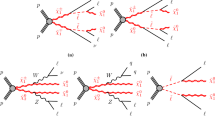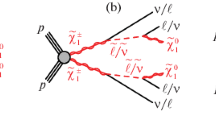Abstract
Supersymmetry, or SUSY, is one of the proposed extensions to the Standard Model, representing a solution to some of its limitations, such as the hierarchy problem. It introduces new particle states which may be produced at the ATLAS experiment, which has been taking data at \(\sqrt{s}=13\) TeV at the Large Hadron Collider (LHC). Due to existing constraints on the value of the masses of strongly coupled SUSY particles (or ‘‘sparticles’’), the electroweak production of weakly interacting sparticles may become the key mechanism to search for beyond-the-Standard-Model physics at the LHC. A search for electroweak production of charginos and neutralinos decaying to multileptonic final states using Run 2 data collected with the ATLAS experiment is presented. Results are interpreted in the context of simplified models in which charginos and neutralinos undergo \(R\)-parity-conserving decays via intermediate production of gauge and Higgs bosons.
Similar content being viewed by others
Explore related subjects
Discover the latest articles, news and stories from top researchers in related subjects.Avoid common mistakes on your manuscript.
1 INTRODUCTION
Supersymmetry (SUSY) [1] is one of the theoretical extensions of the Standard Model (SM). With SUSY it is possible to ensure the naturalness in the prediction of physics observables at higher energy than the electroweak scale. In addition, in many SUSY models, if \(R\)-parity [2] is conserved, SUSY particles (sparticles) must be produced in pairs and the Lightest Supersymmetric particle (LSP) is stable, electrically neutral, and weekly interacting. The LSP would then constitute a viable candidate for dark matter, producing collider signatures with large missing transverse momentum.
In the ATLAS experiment [3] at the LHC [4], the cross section for producing sparticle pairs is highly dependent on their mass [5–7]. Strongly interacting sparticles (squarks and gluinos) generally have larger cross sections than electroweakly-interacting sparticles of equal masses. In particular, charginos (\(\widetilde{\chi}^{\pm}_{i}\), \(i=1,2\)) and neutralinos (\(\widetilde{\chi}^{0}_{j}\), \(j=1,2,3,4\)) are the mass eigenstates (states are ordered by increasing values of their mass) formed from the linear superposition of the SUSY partners of the Higgs and electroweak gauge bosons: higgsino, wino and bino. If squarks and gluinos were much heavier than charginos and neutralinos, then the electroweak production of the latter may be the dominant SUSY process at the LHC. Existing limits on the masses of squarks and gluinos [8] extend well beyond the TeV scale. Therefore, electroweak direct productions of \(\widetilde{\chi}^{\pm}_{1}\widetilde{\chi}^{0}_{2}\) decaying in multileptonic final states may be important probes to search for SUSY at the LHC.
2 \({\widetilde{\chi}^{\pm}_{1}\widetilde{\chi}^{0}_{2}\rightarrow W\,Z/h\rightarrow 3\ell}\) SEARCH
In this section a search for direct \(\widetilde{\chi}^{\pm}_{1}\widetilde{\chi}^{0}_{2}\) production into a three-lepton (electrons or muons) final state is described in the context of two \(R\)-parity conserving simplified models (Fig. 1). In both of them, \(\widetilde{\chi}^{\pm}_{1}\) and \(\widetilde{\chi}^{0}_{2}\) are assumed to be mass-degenerate and purely Wino. The \(\widetilde{\chi}^{\pm}_{1}\) decays to an on-shell \(W\) boson and a \(\widetilde{\chi}^{0}_{1}\)—a Bino-like, stable LSP. The \(\widetilde{\chi}^{0}_{2}\) decays to a \(\widetilde{\chi}^{0}_{1}\) and either a \(Z\) (\(WZ\)-\(3\ell\) model) or a Higgs boson (\(Wh\)-\(3\ell\) model). The final state considered is that with three isolated electrons or muons, missing transverse momentum—from the undetected neutrinos and neutralinos—and light (not \(b\)-tagged) jets.
Diagrams of the production of \(\widetilde{\chi}^{\pm}_{1}/\widetilde{\chi}^{0}_{2}\) decaying to \(3\ell\) via \(WZ\) (a) and \(Wh\) (b). Adapted from [10] (https:// cds.cern.ch/record/2719521/files/ATLAS-CONF-2020-015.pdf). Distributed under the CC-BY-4.0 license.
Event selections enriched in signal (signal regions, or SRs), are designed independently for the two targeted models. Two of the three leptons in the final state are required to be consistent with the decay of a \(Z\) or Higgs boson, whilst the remaining lepton is associated with the \(W\) boson. Events targeting the \(WZ\)-\(3\ell\) model are selected by requiring the presence of a pair of same flavor opposite sign (SFOS) leptons whose invariant mass is compatible with \(m_{Z}\). If more then one SFOS pair is present in the event, the pair with the invariant mass closest to \(m_{Z}\) is associated with the decay of the \(Z\) boson. Events targeting the \(Wh\)-\(3\ell\) model are selected by requiring either at least one SFOS pair with invariant mass not compatible with \(m_{Z}\), or a different flavor opposite sign (DFOS) lepton pair and a third lepton (associated with the \(W\) boson) forming a same flavor same sign (SFSS) pair with one of the other two leptons (no SFOS pairs). This reflects the fact that lepton pairs from the Higgs boson decay are not necessarily of the same flavor. The SM backgrounds for this search can be divided into irreducible and reducible. To the first category belong all those backgrounds with a final state analogous as that expected from the signal, such as fully-leptonically decaying SM \(WZ\) events, which is also the dominant background for this search. The \(WZ\) yields in Monte Carlo (MC) simulations are normalised to data in dedicated control regions (CRs). SM events with at least one fake or non-prompt lepton—such as in \(t\bar{t}\) or \(Z\) + jets processes—make up the reducible background, which is estimated through the use of data-driven techniques. The search is then carried out using sophisticated multi-bin SRs, which take into consideration the differences in signal and background kinematics and composition. All SRs, CRs, and validation regions (VRs) are designed to be orthogonal to one another. The final background estimate is obtained with a profile log-likelihood fit [9], simultaneous in all CRs and SRs.
The full Run 2 results from the data observed in all SRs show no significant excess with respect to the SM prediction (Fig. 2). Model-dependent upper limits on \(m(\widetilde{\chi}^{\pm}_{1}/\widetilde{\chi}^{0}_{2})\) and \(m(\widetilde{\chi}^{0}_{1})\) at 95% Confidence Level (CL) are set for each of the two simplified model scenarios taken into account (Fig. 3) using the \(\textrm{CL}_{\textrm{s}}\) prescription in the signal-plus-background hypothesis [11]. For the \(WZ\)-\(3\ell\) model, \(m(\widetilde{\chi}^{\pm}_{1}/\widetilde{\chi}^{0}_{2})\) are excluded up to 660 GeV for a massless \(\widetilde{\chi}^{0}_{1}\), and up to 300 GeV for mass splittings between \(\widetilde{\chi}^{\pm}_{1}/\widetilde{\chi}^{0}_{2}\) and \(\widetilde{\chi}^{0}_{1}\) near \(m_{Z}\). For the \(Wh\)-\(3\ell\) model, \({m(\widetilde{\chi}^{\pm}_{1}/\widetilde{\chi}^{0}_{2})}\) are excluded up to 185 GeV for \(m(\widetilde{\chi}^{0}_{1})\) below 20 GeV. In this case, the observed exclusion limit is weaker than the expected limit, which is explained by the mild excess found in one of the DFOS SRs; the limits are however compatible within \(2\sigma\). These results have been recently published [10], and the obtained exclusion limits are greatly improved compared to the previous equivalent search using the Run 1 8 TeV dataset [12].
3 \({\widetilde{\chi}^{\pm}_{1}\widetilde{\chi}^{0}_{2}\rightarrow Wh\rightarrow 2\ell}\) SAME SIGN SEARCH
A search for direct \(\widetilde{\chi}^{\pm}_{1}\widetilde{\chi}^{0}_{2}\) production has also been carried out in a final state with two leptons (electrons or muons) with the same sign (SS). The simplified model taken into account—referred to as \(Wh\)-SS—considers on-shell decay of \(\widetilde{\chi}^{\pm}_{1}\) and \(\widetilde{\chi}^{0}_{2}\) to \(W\) and Higgs bosons, respectively, as shown in Fig. 4. The model assumptions are the same as in the \(3\ell\) case.
The complementarity between the \(WZ\)-\(3\ell\), \(Wh\)-\(3\ell\), and \(Wh\)-SS models facilitates the statistical combination of these multileptonic SUSY searches to further probe the available phase space in search for physics beyond the SM. The search strategy in \(Wh\)-SS also follows a similar approach to the \(3\ell\) case, by considering orthogonal SRs, VRs, and CRs. The dominant, irreducible SM background comes from fully-leptonically decaying \(WZ\) processes, in which one of the two leptons from the \(Z\)-boson decay escapes detection, leaving a same-sign lepton pair. Along with the reducible background from fake/non-prompt leptons, another background source comes from SM processes with an opposite-sign lepton pair in which the charge of one lepton—typically an electron—is misreconstructed (referred to as charge-flip).
Early Run 2 results [13] show good agreement with the SM prediction (Fig. 5) and therefore \(m(\widetilde{\chi}^{\pm}_{1}/\widetilde{\chi}^{0}_{2})\) and \(m(\widetilde{\chi}^{0}_{1})\) are excluded up to 230 and 40 GeV, respectively.
4 CONCLUSIONS
The search for electroweak direct production of \(\widetilde{\chi}^{\pm}_{1}/\widetilde{\chi}^{0}_{2}\) with boson-mediated decays to multileptonic final states is one of the key analyses to search for SUSY at the ATLAS experiment at the LHC. The possibility to statistically combine the results from the \(2\ell\)-SS and \(3\ell\) channels will allow to further probe the SM predictions in specific phase spaces whilst searching for physics beyond the SM.
REFERENCES
S. P. Martin, Adv. Ser. Direct. High Energy Phys. 21, 1 (2010); hep-ph/9709356.
G. R. Farrar and P. Fayet, Phys. Lett. B 76, 575 (1978).
ATLAS Collab. (G. Aad et al.), JINST 3, S08003 (2008).
L. Evans and P. Bryant, JINST 3, S08001 (2008).
B. Fuks, M. Klasen, D. R. Lamprea, and M. Rothering, JHEP 1210, 081 (2012); arXiv: 1207.2159.
B. Fuks, M. Klasen, D. R. Lamprea, and M. Rothering, Eur. Phys. J. C 73, 2480 (2013); arXiv: 1304.0790.
ATLAS Collab. https:// twiki.cern.ch/twiki/bin/view/LHCPhysics/ SUSYCrossSections
M. Aaboud et al. (ATLAS Collab.), Phys. Rev. D 97, 112001 (2018); arXiv: 1712.02332.
G. Cowan, K. Cranmer, E. Gross, and O. Vitells, Eur. Phys. J. C 71, 1554 (2011); arXiv: 1007.1727.
ATLAS Collab., ATLAS-CONF-2020-015. https:// cds.cern.ch/record/2719521
A. L. Read, J. Phys. G 28, 2693 (2002).
ATLAS Collab., JHEP 1404, 169 (2014); arXiv: 1402.7029.
M. Aaboud et al., ATLAS Collab., Phys. Rev. D 100, 012006 (2019); arXiv: 1812.09432.
Author information
Authors and Affiliations
Consortia
Corresponding author
Rights and permissions
About this article
Cite this article
Aparo, M., the ATLAS collaboration. Search for Electroweak Production of Charginos and Neutralinos in Multileptonic Final States with the ATLAS Experiment. Phys. Atom. Nuclei 84, 540–543 (2021). https://doi.org/10.1134/S1063778821040050
Received:
Revised:
Accepted:
Published:
Issue Date:
DOI: https://doi.org/10.1134/S1063778821040050









